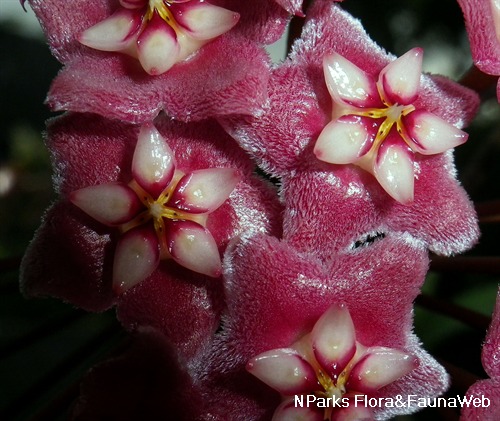
Name
Classifications and Characteristics
| Plant Division | Angiosperms (Flowering Seed Plants) |
|---|---|
| Plant Growth Form | Climber, Epiphyte |
| Lifespan (in Singapore) | Perennial |
| Mode of Nutrition | Autotrophic |
Biogeography
| Native Distribution | Philippines and Borneo (Kalimantan and Sabah). |
|---|---|
| Native Habitat | Terrestrial |
| Preferred Climate Zone | Tropical |
Description and Ethnobotany
| Growth Form | It is an epiphyte with glabrous and branching stems, climbs up to 2 m long. |
|---|---|
| Foliage | The leaves are elliptic to obovate, measuring about 4 - 7 cm x 3 - 4 cm, thick with pinnate venation, and has round petiole. The leaf blade has mid-vein and lateral veins cream to yellow. The leaves turn red when exposed to sunlight. |
| Flowers | Flowers are borne in clusters of 4 - 5 cm in diameter, with each cluster consisting of 20 - 30 flowers. The flowers have strong spicy fragrance at night. Flowers are pink or cream, pubescent. |
| Fruit | Fruits are linear-shaped, measuring 8 cm long. |
| Habitat | Found in riverine forest and mixed hill dipterocarp forests. |
| Similar | Similar to Hoya nabawanensis, but H. obscura is free-flowering and has fragrance compared to H. nabawanensis which has little to no fragrance, and corolla lobes are almost smooth. |
| Etymology | The genus Hoya means wax flower. The specific epithet obscura means obscure, not clearly known about, requires further taxonomic and studies. |
Landscaping Features
| Desirable Plant Features | Ornamental Flowers, Ornamental Foliage |
|---|---|
| Landscape Uses | Container Planting, Suitable for Hanging Baskets |
| Thematic Landscaping | Fragrant / Aromatherapy Garden |
| Usage Hazard - Cons | Toxic Upon Ingestion |
| Usage Hazard - Cons Remarks | Avoid contact with milky/ white sap as it may cause skin irritation in certain individuals. Keep plants away from children and pets as sap could be toxic. |
Fauna, Pollination and Dispersal
| Pollination Method(s) | Biotic (Fauna) |
|---|---|
| Seed or Spore Dispersal | Abiotic |
Plant Care and Propagation
| Light Preference | Semi-Shade |
|---|---|
| Water Preference | Moderate Water |
| Rootzone Tolerance | Easy to Grow |
| Pest(s) | Sucking Insects |
| Propagation Method | Seed, Stem Cutting |
Foliar
| Foliage Retention | Evergreen |
|---|---|
| Mature Foliage Colour(s) | Green |
| Mature Foliage Texture(s) | Smooth |
| Prominent Young Flush Colour(s) | Green |
| Foliar Type | Simple / Unifoliate |
| Foliar Shape(s) | Non-Palm Foliage (Obovate, Elliptical) |
| Foliar Venation | Pinnate / Net |
| Foliar Margin | Entire |
| Mature Foliage Colour(s) Remarks | Leaves attain reddish tinge when exposed to very bright light or direct sunlight |
Floral (Angiosperm)
| Flower Colour(s) | Cream / Off-White, Pink |
|---|---|
| Flower Texture(s) | Velvety / Furry / Tomentose |
| Flower Grouping | Cluster / Inflorescence |
| Flower Location | Axillary |
| Flower Symmetry | Radial |
| Individual Flower Shape | Stellate / Star-shaped |
| Inflorescence Type | Umbel |
| Flowering Period | Free-Flowering, After Rain |
| Flowering Opening Time | Time-Independent |
| Flower Lifespan on Plant | Several Days |
| Flower Colour(s) Remarks | Color of infloresence appears to be dependent on exposure to bright light during the course of development - in cultivated specimens, growers have observed that flowers that developed in full/ deep shade are dull pink, whereas those that developed in bright light/ exposed to some direct sunlight are cream or yellowish in color. |
Fruit, Seed and Spore
| Fruit Classification | Simple Fruit |
|---|---|
| Fruit Type | Dehiscent Dry Fruit |
Image Repository
Others
| Master ID | 30866 |
|---|---|
| Species ID | 5236 |
| Flora Disclaimer | The information in this website has been compiled from reliable sources, such as reference works on medicinal plants. It is not a substitute for medical advice or treatment and NParks does not purport to provide any medical advice. Readers should always consult his/her physician before using or consuming a plant for medicinal purposes. |


_lowres.jpg)
_lowres.jpg)
_lowres.jpg)



